Avicenna J Environ Health Eng. 6(1):49-54.
doi: 10.34172/ajehe.2019.07
Original Article
Physico-chemical, Calorific, and Emission Performance of Briquettes Produced from Maize Cob, Sugarcane Bagasse, and Polythene Composites
Owolabi Ayowole Awwal *  , Omoniyi Kehinde Israel , Zakka Yashim
, Omoniyi Kehinde Israel , Zakka Yashim
Author information:
Department of Chemistry, Ahmadu Bello University, Zaria, Nigeria
Abstract
Global waste generation has been a challenging issue that vastly affects humans and the environment. The conversion of a vast amount of agricultural and polymeric waste to briquette may bridge the energy deficit and environmental pollution issues in developing economies. On the other hand, the utilization of biomass waste or residue as an energy source could help alleviate dependence on imported energy and its use continues to be a topical issue in both developing and developed countries. Over the years, biomass has been an important source of generating energy due to its relative availability and the ability to meet both heat and electricity demands by contributing towards international commitments so as to minimize environmental degradation and maximize environmental, social, and economic sustainability. The benefits of compacted biomass compared to all other types of biofuel include its low transportation and storage costs, uniform product quality such as constant humidity content, and high mass fluency. Moreover, fuel wood and biomass residues have low combustion efficiency, posing environmental and health hazards. This research studies the performance of briquettes produced from maize cob, sugarcane bagasse, and polythene waste composites. The briquettes were agglomerated using cassava starch binder (CSB) and plantain peel binder (PPB) at binder concentrations of 4%, 12%, and 20%. Each briquette was characterized in terms of proximate analysis, calorific value, ultimate analysis and micro-structure by scanning electron microscopy. The briquettes had a moisture content of 5.39-12.10%, volatile matter of 10.15- 23.08%, ash content of 10.29-24.63%, fixed carbon content of 55.84-77.10%, calorific value of 9.04-28.14 MJ/kg, carbon content of 77%-8405%, nitrogen content of 0.875-1.05%, and sulphur content of 0.4-0.7%. The results obtained from this study revealed that briquette produced using CSB at binder concentration of 4% had the best properties required for biomass fuel briquette compared to briquette produced using PPB and suggested its use for the production of environmentally friendly solid fuel.
Keywords: Biomass waste Conversion, Environmental pollution, Fuel Briquette, Waste Management
Copyright and License Information
© 2019 The Author(s); Published by Hamadan University of Medical Sciences.
This is an open-access article distributed under the terms of the Creative Commons Attribution License (
http://creativecommons.org/licenses/by/4.0), which permits unrestricted use, distribution, and reproduction in any medium provided the original work is properly cited.
1. Introduction
World’s major cities are today contending with the elimination of mounting heaps of solid waste from domestic, industrial, and craft activities. Refuse generation and its effects on health and environmental quality have become national issues. The most critical and immediate problems faced by developing countries and cities are the impacts of urban pollution on the health of people as well as air pollution, especially from particulates. Today, waste generation and disposal are among the pressing environmental issues in the world (1). In this regard, efficient management of waste is a global concern, requiring extensive research and development towards exploring newer applications for a sustainable and environmentally sound management. However, only a small proportion of the residues are being used as fuel because of their high moisture, high polymorphism, and low energy density. These troublesome characteristics increase costs of transport, handling and storage, making use of biomass as a fuel impractical (2). Some of these drawbacks can be overcome through densification of biomass residues for briquette production. In order to upgrade biomass residues for a variety of applications, their original forms characterized by high moisture content, irregular shapes and sizes, low bulk density, difficulty in handling, transporting, and storing, have to undergo some changes to make their use more practical and economical (3). Some of these drawbacks can be overcome through densification of biomass residues with appropriate binders for briquette production. Several studies reported production of briquette from rice husk mixed with corn cobs and aggregated with starch binder (4), rice husk and bran with cassava binder and okra stem gum (5), bagasse, clay and molasses (6), wood charcoal bonded with Arabic gum and cassava starch binder (CSB) (7), low-rank coal and sawdust biomass waste (8).
Maintaining biomass as a significant contributor to national energy supply for many countries is an approach to ensure greater autonomy and cheap energy production for industrial use. This serves in a lot of ways among which are creation of employment opportunities in rural districts. The use of waste as biomass fuel could be an alternative solution for getting rid of waste through production of fuel briquettes (9). In addition, the utilization of biomass for energy production is an alternative way to solve increasing environmental problems such as CO2, SO2 and NO2 increase in the atmosphere caused by the combustion of fossil fuels which results in global warming. Furthermore, the use of biomass for energy purposes minimizes SO2 emission as biofuels contain minimalsulphur.
2. Materials and Methods
Approximately 500 kg of each sample (the maize cob and sugarcane waste) was collected from farm settlement at Zaria (Latitude 11.0855° N and Longitude 7.7199° E) and Saminaka (Latitude 10.4165° N, Longitude 8.6814° E) in February 2018. Moreover, the plantain peel used in this study was obtained from a restaurant in Zaria in February 2018, while the cassava starch was procured from a local market, and the polythene waste used for the study was collected from a dumpsite in Zaria, Nigeria. Afterwards, it was sorted, cleaned in distilled water and sun-dried for 12 hours so as to reduce the moisture content which was about 46% when it was collected. The dried maize cob was cut into smaller sizes of 30-60 mm using a mortar and pestle to provide more surface area for carbonization. Each of the maize cob and sugarcane waste samples was then carbonized at a temperature of 400°C in a 200-L vertical oil drum kiln using conventional drum method (10), after which it was ground into smaller particles using a hammer mill with a mesh size of 6 mm. The sieved and carbonized maize cobs and sugarcane briquettes were re-sieved using a sieve with a mesh size of 2.5 mm in order to remove impurities and to achieve uniform sized particles. The collected polythene was chopped into smaller pieces using a pair of scissors.
2.1. Preparation of Cassava Starch Binder
The cassava starch was prepared by 20 g, 60 g and 100 g of cassava starch using three different labelled plastic bowls. Then, 500 cm3 of water was measured using a measuring cylinder, out of which 100 cm3 was used to dissolve the cassava starch in a plastic bowl. The remaining 400 cm3 was poured into an electric kettle and allowed to boil at 100°C. Then, hot water was then gradually poured into the starch mixture and stirred to form cassava starch paste. This resulted to 4%, 12%, and 20% by weight of CSB.
2.2. Preparation of Plantain Peel Binder
The moisture content of the fresh plantain peels collected was determined using a moisture meter at Laboratory of Department of Chemical Engineering, Ahmadu Bello University. Then, the plantain peels were cut into smaller sizes with a knife and sun-dried, after which the moisture content was determined again using a moisture meter (PM650, USA) until it reached 15% (11). The dried peels were then ground in a machine shop using a mechanical mill with a mesh size of 20 mm. Then, they were sieved to particle size of 2 mm. The plantain peels were then added to 500 cm3 of distilled water which was then used to prepare 4%, 12% and 20% binder mixture.
2.3. Preparation of Briquette
The carbonized maize cob, sugarcane waste, and shredded polythene waste were mixed with CSB or plantain peel binder (PPB) in ratios of 1:1, 1:2, and 2:1. Then, the fuel briquettes from each set were formed in a fabricated briquetting press, which consists of a cylinder with an internal diameter of 60 mm and length of 100 mm. Compaction was done using a hydraulic jack with a pressure of 2.5 MPa. The briquettes obtained for each set were sun-dried for two days.
2.4. Method of Analysis
The moisture content of the briquettes was determined using American Standard Testing Methods (ASTM) D 6980-17 (12). The volatile matter in each briquette type was determined based on ASTM D-3175-18 (13). The ash content was determined based on ASTM D 3174-12 (14). The calorific value of each group of briquettes produced as a function of binder type and biomass mix ratio was determined using Parr Oxygen bomb calorimeter (P6100, Parr, USA) at Chemical Engineering Department of Ahmadu Bello University, Zaria, in accordance with ASTM D5865-13, 2004. The surface morphology of the carbonized biomass samples was assessed using Scanning electron microscope (Phenom Prox, Phenomworld Eindhoven, the Netherlands).
3. Results and Discussion
3.1 Moisture Content of Briquette
The moisture content of the briquettes produced using CSB ranged from 5.71 to 10.10 wt.%, while the briquettes produced using PPB ranged from 5.39% to 12.10 wt.% as shown in Figs. 1 and 2. The higher the moisture content, the lower the calorific energy value, the higher the volatile matter and ash content. Therefore, low moisture content reported in this study places the briquette as a quality one. The least moisture content (5.39%) was recorded for briquette produced using PPB with binder concentration of 4% and mix ratio of 1:1. The moisture content of briquettes produced in this study agrees with literature recommendation (5 to 12%) for good and quality briquettes as reported by Chin and Siddiqui (15). The moisture content of 5.39% obtained for briquette in this study using CSB is lower compared to 6.01% and 10% moisture content reported by Kenechukwu and Kelvin for briquette produced from empty fruit branches, using cassava and asphalt as binder (16).
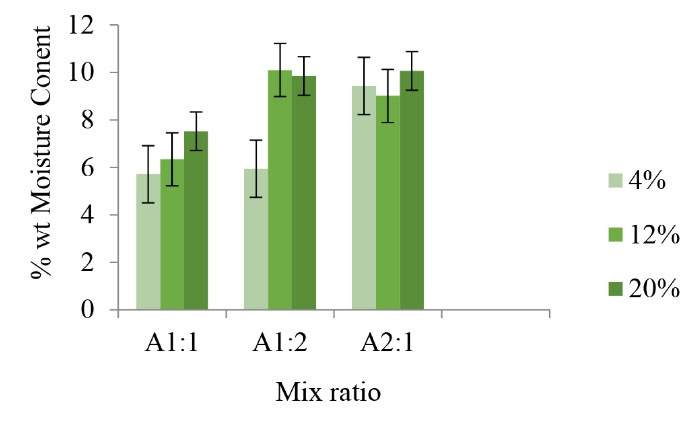
Figure 1.
Moisture Content of CSB Briquettes.
.
Moisture Content of CSB Briquettes.
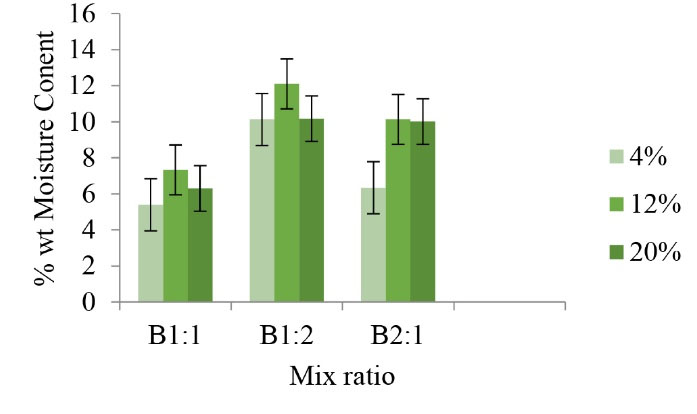
Figure 2.
Moisture Content of PPB Briquettes.
.
Moisture Content of PPB Briquettes.
3.2. Volatile Matter of Briquette
The volatile matter of the briquettes produced was in the range of 10.15%-18.10% using CSB, while the briquettes produced using PPB ranged from 13.86 to 22.59% as shown in Figs. 3 and 4. The higher the volatile matter, the higher the volatile gases released when the fuel briquettes are combusted. The least volatile matter (10.15%) was observed in the briquette with binder concentration of 4% and mix ratio of 1:2 using CSB. This is low compared to 60.39%, 75.67%, and 89.47% reported by Emerhi, for briquettes produced from Afzelia africana, Terminalia superba, and Milicia excelsa using ash, cow dung, and starch as binding agent, respectively (17). However, the volatile matter of the briquettes produced in this study agrees with the recommended range of 10%-25% for a good and quality briquette (18). Briquette samples produced using CSB was significantly affected by mix ratio while mix ratio had no significant effect on volatile matter of briquette samples produced using PPB.
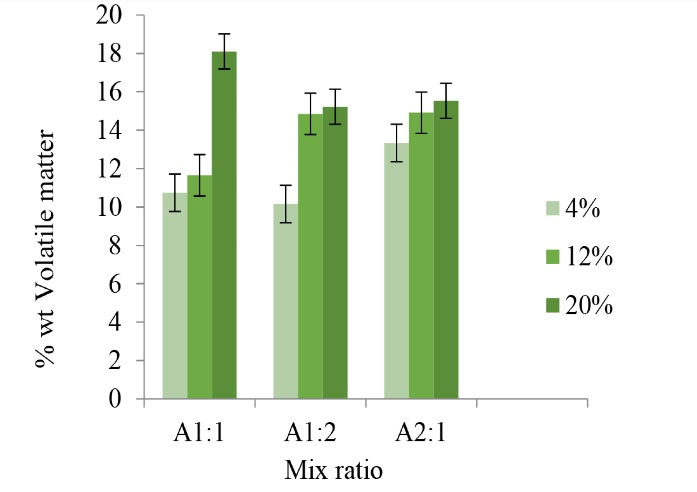
Figure 3.
Volatile Matter of CSB Briquettes.
.
Volatile Matter of CSB Briquettes.
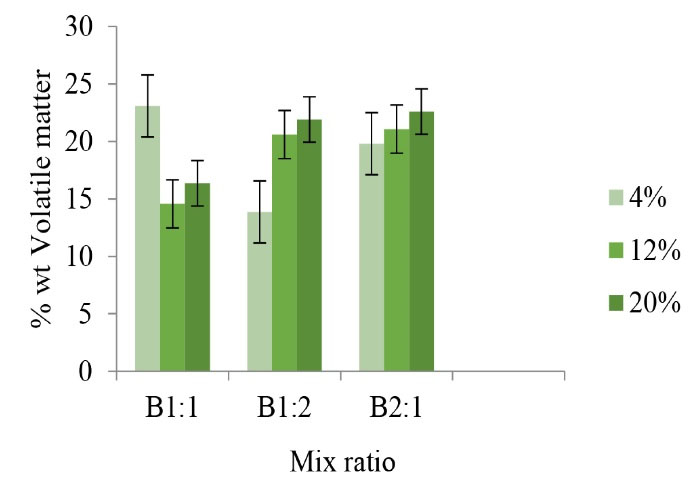
Figure 4.
Volatile Matter of PPB Briquettes.
.
Volatile Matter of PPB Briquettes.
3.3. Ash Content of Briquette
As shown in Figs. 5 and 6, the ash content of the briquettes produced in this study using CSB ranged from 10.29 to 14.21%, while the ones produced using PPB had a range of 14.43 to 24.63%. The lowest ash content (10.29%) was seen in the sample having binder concentration of 20% and mix ratio of 2:1 using CCB. This is quite low compared to ash content (28.13%) of briquette produced by Emerhi from A. africana, T. superba, and M. excelsa using ash as binder (17). This implies that the briquettes would have reduced ash when used in stove, furnace, and gasifiers. Mix ratio did not significantly affect the ash content of briquette produced using CSB, while the mix ratio had significant effect on ash content of briquette produced using PPB.
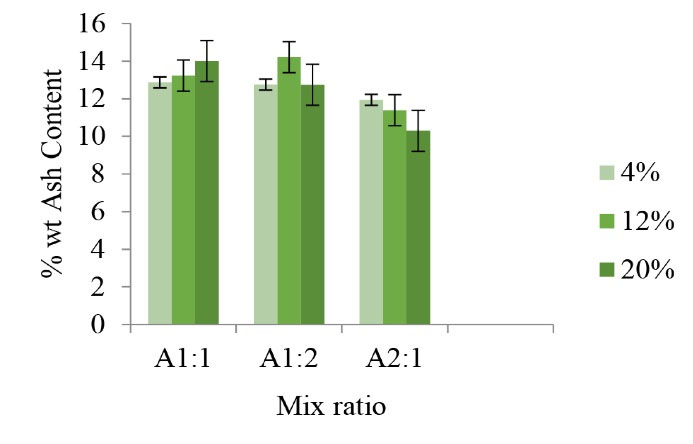
Figure 5.
Ash Content of CSB Briquettes.
.
Ash Content of CSB Briquettes.
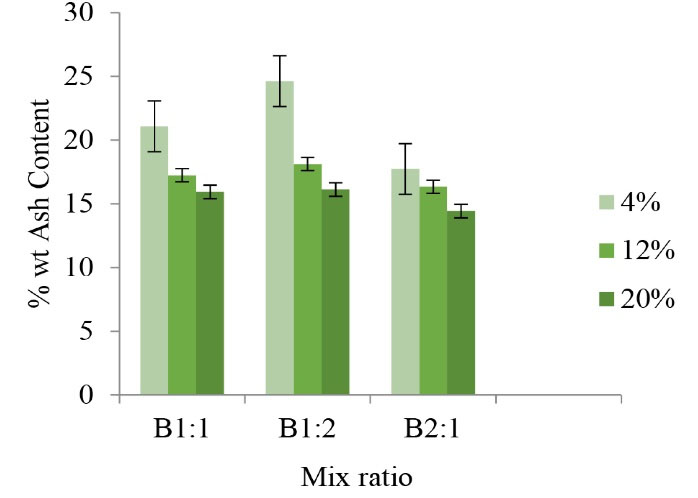
Figure 6.
Ash Content of PPB Briquettes.
.
Ash Content of PPB Briquettes.
3.4. Fixed Carbon Content of Briquette
As shown in Figs. 7 and 8, the fixed carbon content of the briquette produced was in the range of 55.84 to 77.10%. The briquettes produced using CSB had fixed carbon content in the range of 67.9% to 77.1%, while the ones produced using PPB had fixed carbon content ranging from 55.84% to 68.2%. The range of fixed carbon content reported in this study was higher when compared to the results (5.75 to 8.28%) reported by Adetogun et al, for the fuel briquette produced using maize cob biomass and starch as binder (19). The higher the fixed carbon content of briquettes, the higher the calorific value, leading to a better quality of the briquette (20). Mix ratio has no significant effect on the fixed carbon content of briquettes produced using CSB and PPB.
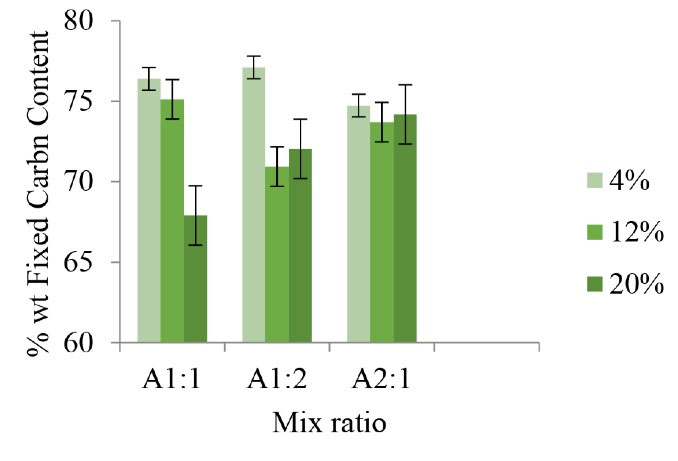
Figure 7.
Fixed Carbon Content of CSB Briquettes.
.
Fixed Carbon Content of CSB Briquettes.
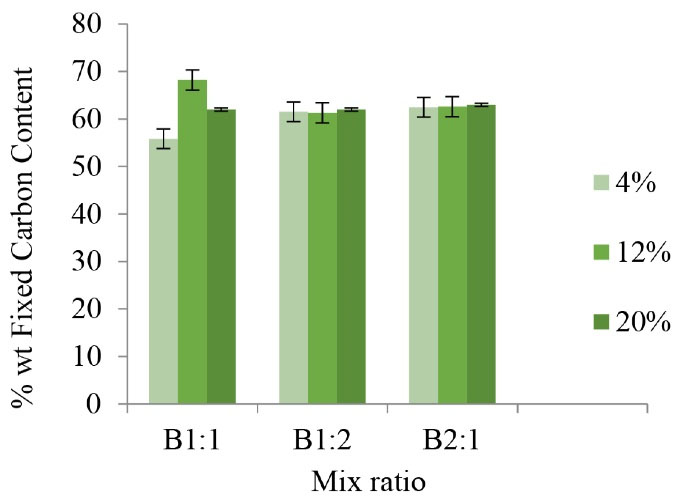
Figure 8.
Fixed Carbon Content of PPB Briquettes.
.
Fixed Carbon Content of PPB Briquettes.
3.5. Calorific Value of Briquette
The calorific value of the briquettes produced in this study using CSB was in the range of 13.38 to 28.14 MJ/kg, while the ones produced using PPB has calorific value in the range of 9.04 to 19.94 MJ/kg as shown in Figs 9 and 10. The highest calorific value was 28.14 MJ/kg at binder concentration of 4% with mix ratio of 1:1 using CSB. The calorific value of 28.14 MJ/kg reported for the produced briquette in this study was higher compared to 18.80 MJ/kg reported by Murali et al for sugarcane waste briquettes without binding agent (21) and 17.83 MJ/kg reported by Pongsak for rice straw and sugarcane leaves briquettes using molasses as binder (22). Mix ratio did not have any significant effect on the calorific value of briquettes produced using CSB and PPB.
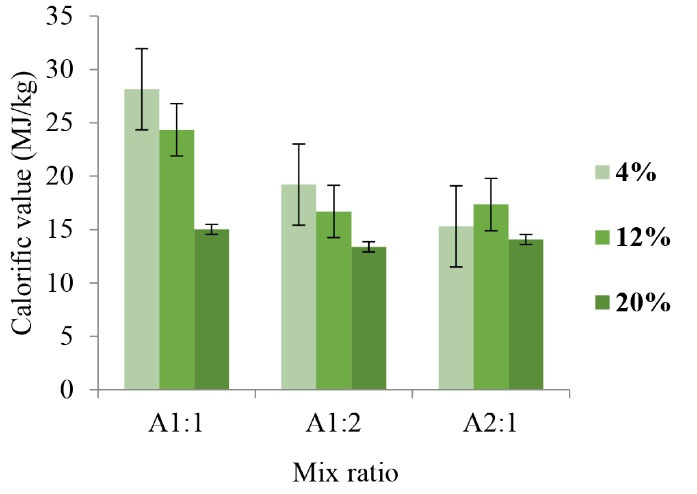
Figure 9.
Calorific Value of CSB Briquettes.
.
Calorific Value of CSB Briquettes.
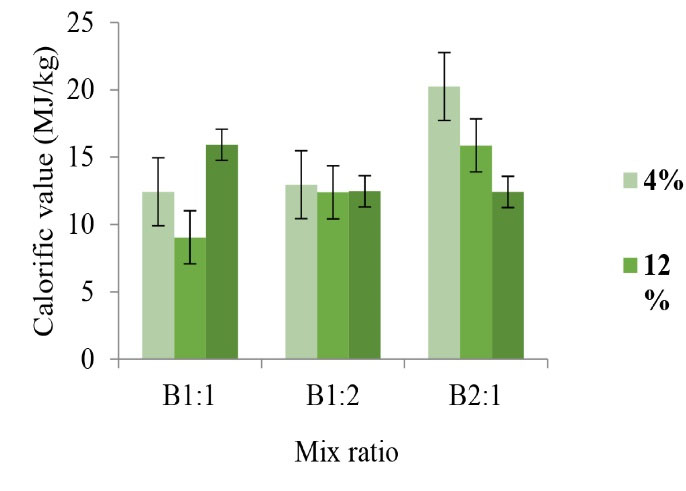
Figure 10.
Calorific Value of PPB Briquettes.
.
Calorific Value of PPB Briquettes.
3.6. Scanning Electron Microscope Analysis of Briquette
As shown in Figs.11 and 12, little voids were observed in the composite samples as the spaces between the interface layers have been sealed up by CSB and PPB used. From the SEM result, it can be assumed that good fiber shape after forming the briquette leads to high carbon yields (84.5% and 77%). High interaction and compatibility of composite matrix can be deduced between the carbonized biomass waste materials and CSB due to the spread of the binding material compared to PPB where the binders are concentrated at a point.
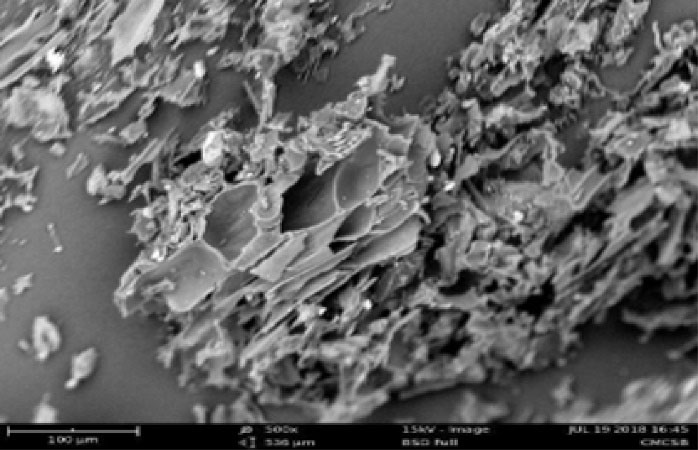
Figure 11.
SEM Image of CSB Briquettes (×500).
.
SEM Image of CSB Briquettes (×500).
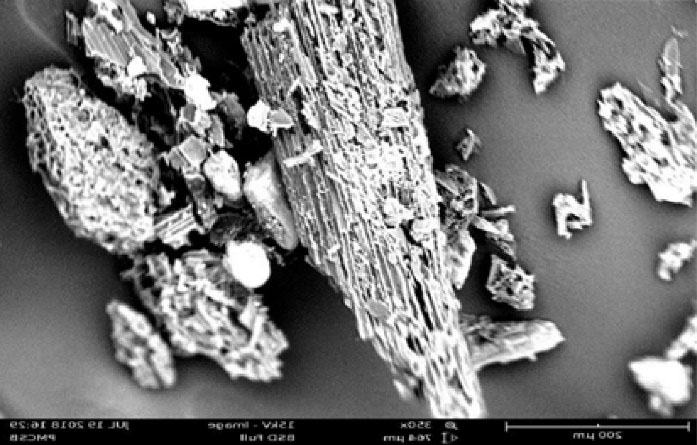
Figure 12.
SEM Image of PPB Briquettes (×500).
.
SEM Image of PPB Briquettes (×500).
3.7. Percentage of Carbon, Nitrogen, and Sulphur of Briquettes
Based on the results of the elemental analysis, the fuel briquettes produced using CSB had 84.5% carbon, 0.875% nitrogen, and 0.4% sulphur contents, while the briquette produced using PPB had 77% carbon, 1.05% nitrogen, and 0.7% sulphur contents. This was very high compared to 46.49-55.85% reported for briquette produced using Bauhinia purpurea, Papaya leaves and wood waste using Maida (Wheat) as binder as reported by Raju et al. The nitrogen content of the briquette produced in this study was very low compared to 0.99-3.59% reported by Raju et al (23) and 1.02% reported by Efomah and Gbabo for briquette produced using rice husk and starch as binder (24). The sulphur content reported in this work was also lower than 0.82% reported by Oladeji for corn cob briquette (25).
4. Conclusion
It can however be concluded that the briquettes produced in this research work using CSB had low moisture content (5.71%), low volatile matter (10.15%), low ash content (10.29%), high fixed carbon content (77.10%) and high calorific value (28.14 MJ/kg), high carbon content (84.5%), low nitrogen content (0.875%), and low sulphur content (0.4%). The spread of binder observed also confirmed the high interaction and compatibility of carbonized biomass waste with CSB compared to briquette produced using PPB where the binder was concentrated at a point. Biomass briquettes are widely used for any type of thermal application such as steam generation in boilers, kilns, gasifiers, furnace, forges, and foundries. Briquette fuel can be used for industrial, commercial, and household domestic purposes such as cooking, heating, and food processing in both rural and urban areas. It is recommended that the use of briquette be given wide publicity in Nigeria due to heaps of waste generated in the environment and the long duration it takes to biodegrade polymeric waste. Moreover, there is a need to strengthen research in alternative energy sources especially the ones that convert waste to wealth.
Conflict of Interest Disclosure
The authors declare that there is no conflict of interests that would prejudice the impartiality of this scientific work.
Ethical Issues
Authors are aware of, and comply with, best practice in publication ethics specifically with regard to authorship (avoidance of guest authorship), dual submission, manipulation of figures, competing interests and compliance with policies on research ethics. Authors adhere to publication requirements that submitted work is original and has not been published elsewhere in any language.
References
- Momodu NS, Dimuna KO, Dimuna JE. Mitigating the impact of solid wastes in urban centres in Nigeria. Journal of Human Ecology 2011; 34(2):125-33. doi: 10.1080/09709274.2011.11906377 [Crossref] [ Google Scholar]
- Nasrin AB, Ma AN, Choo YM, Mohamad S, Rohaya MH, Azali A. Oil palm biomass as potential substitution raw materials for commercial biomass briquettes production. Am J Appl Sci 2008; 5(3):179-83. doi: 10.3844/ajassp.2008.179.183 [Crossref] [ Google Scholar]
- Kaliyan N, Morey RV. Densification characteristics of corn cobs. Fuel Process Technol 2010; 91:559-65. doi: 10.1016/j.fuproc.2010.01.001 [Crossref] [ Google Scholar]
- Muazu RI, Stegemann JA. Effects of operating variables on durability of fuel briquettes from rice husks and corn cobs. Fuel Process Technol 2015; 133:137-45. doi: 10.1016/j.fuproc.2015.01.022 [Crossref] [ Google Scholar]
- Yank A, Ngadi M, Kok R. Physical properties of rice husk and bran briquettes under low pressure densification for rural applications. Biomass Bioenergy 2016; 84:22-30. doi: 10.1016/j.biombioe.2015.09.015 [Crossref] [ Google Scholar]
- Onchieku JM, Chikama BN, Rao MS. Optimum parameters for the formulation of charcoal briquettes using bagasse and clay as binder. Eur J Sustain Dev 2012; 1(3):477-92. doi: 10.14207/ejsd.2012.v1n3p477 [Crossref] [ Google Scholar]
- Sotannde OA, Oluyege AO, Abah GB. Physical and combustion properties of charcoal briquettes from neem wood residues. Int Agrophys 2010; 24(2):189-94. [ Google Scholar]
- Blesa MJ, Miranda JL, Moliner R, Izquierdo MT, Palacios JM. Low-temperature co-pyrolysis of a low-rank coal and biomass to prepare smokeless fuel briquettes. J Anal Appl Pyrolysis 2003; 70(2):665-77. doi: 10.1016/S0165-2370(03)00047-0 [Crossref] [ Google Scholar]
- Fernandes ERK, Marangoni C, Souza O, Sellin N. Thermochemical characterization of banana leaves as a potential energy source. Energy Convers Manag 2013; 75:603-8. doi: 10.1016/j.enconman.2013.08.008 [Crossref] [ Google Scholar]
- Ugwu KE, Agbo KE. Briquetting of palm kernel shell. J Appl Sci Environ Manage 2011; 15(3):447-50. [ Google Scholar]
- Grover PD, Mishra SK, Clancy JS. Development of an appropriate biomass briquetting technology suitable for production and use in developing countries. Energy Sustain Dev 1994; 1(1):45-8. doi: 10.1016/s0973-0826(08)60015-0 [Crossref] [ Google Scholar]
- ASTM D6980-17, Standard Test Method for Determination of Moisture in Plastics by Loss in Weight. West Conshohocken, PA: ASTM International; 2017.
- ASTM D3175-18, Standard Test Method for Volatile Matter in the Analysis Sample of Coal and Coke. West Conshohocken, PA: ASTM International; 2018.
- ASTM D3174-12. Standard Test Method for Ash in the Analysis Sample of Coal and Coke from Coal. West Conshohocken, PA: ASTM International; 2018.
- Chin OC, Siddiqui KM. Characteristics of some biomass briquettes prepared under modest die pressures. Biomass Bioenergy 2000; 18(3):223-8. doi: 10.1016/S0961-9534(99)00084-7 [Crossref] [ Google Scholar]
- Ugwu KE, Agbo KE. Evaluation of binders in the production of briquettes from empty fruit bunches of Elais Guinensis. Int J Renew Sustain Energy 2013; 2(4):176-9. doi: 10.11648/j.ijrse.20130204.17 [Crossref] [ Google Scholar]
- Emerhi EA. Physical and combustion properties of briquettes produced from sawdust of three hardwood species and different organic binders. Adv Appl Sci Res 2011; 2(6):236-46. [ Google Scholar]
- Zapušek A, Wirtgen C, Weigandt J, Lenart F. Characterization of carbonizate produced from Velenje lignite in lab-scale reactor. Acta Chim Slov 2003; 50:789-98. [ Google Scholar]
- Adetogun AC, Ogunjobi KM, Are DB. Combustion properties of briquettes produced from maize cob of different particle sizes. Journal of Research in Forestry, Wildlife and Environmental 2014; 6(1):28-38. [ Google Scholar]
- Moore WE, Johnson DB. Procedures for the chemical analysis of wood and wood products. Madison, USA: Forest Products Laboratory Department of Agriculture; 1999.
- Murali G, Channankaiah Channankaiah, Goutham P, Enamul Hasan I, Anbarasan P. Performance study of briquettes from agricultural waste for wood stove with catalytic combustor. Int J Chemtech Res 2015; 8(1):30-6. [ Google Scholar]
- Jittabut P. Physical and thermal properties of briquette fuels from rice straw and sugarcane leaves by mixing molasses. Energy Procedia 2015; 79:2-9. doi: 10.1016/j.egypro.2015.11.452 [Crossref] [ Google Scholar]
- Raju AI, Madhuri N, Prabhakar D, Prem K. Studies on development and effectiveness of fuel briquettes as an alternative energy sources. Int Res J Eng Technol 2017; 4(10):1698-706. [ Google Scholar]
- Efomah AN, Gbabo A. The physical, proximate and ultimate analysis of rice husk briquettes produced from a vibratory block mould briquetting machine. Int J Innov Sci Eng Technol 2015; 2(5):814-22. [ Google Scholar]
- Oladeji JT. Fuel characterization of briquettes produced from corncob and rice husk resides. Pac J Sci Technol 2010; 11(1):101-6. [ Google Scholar]